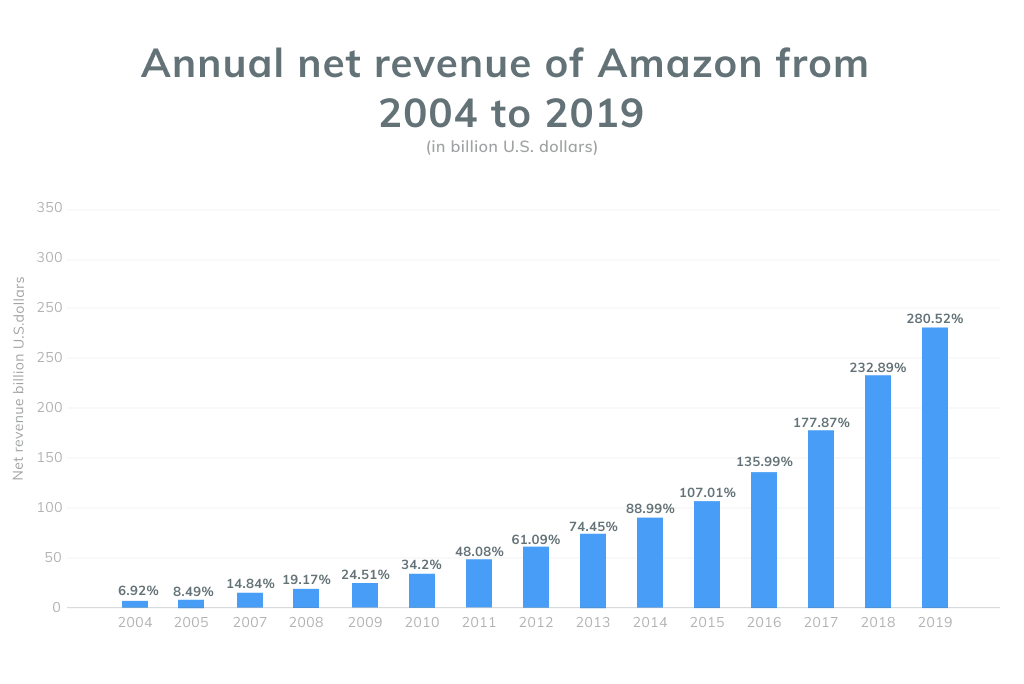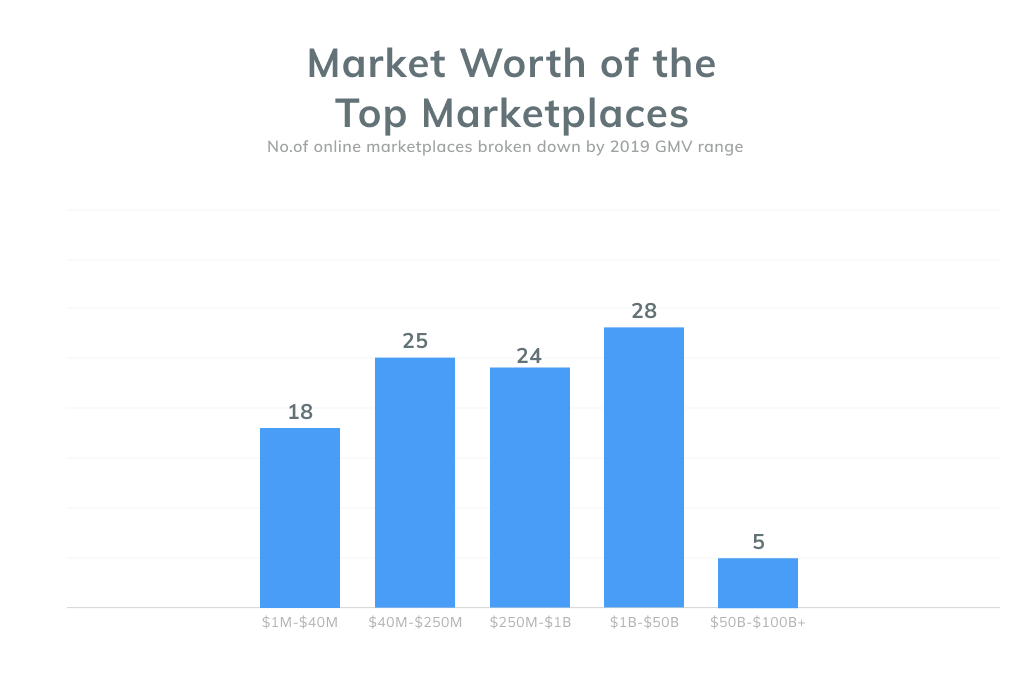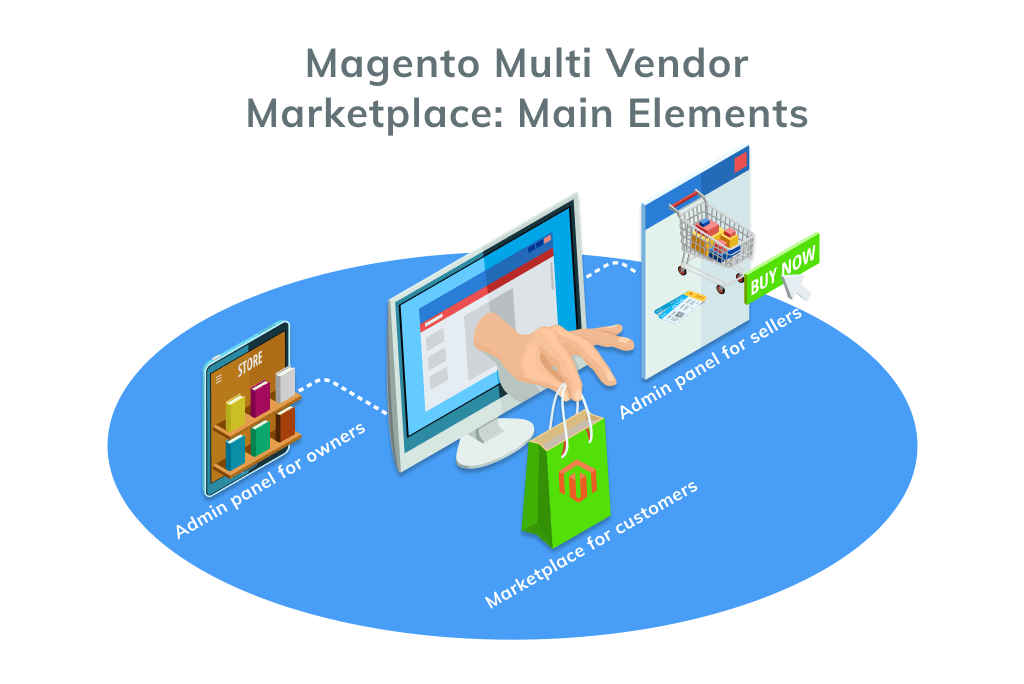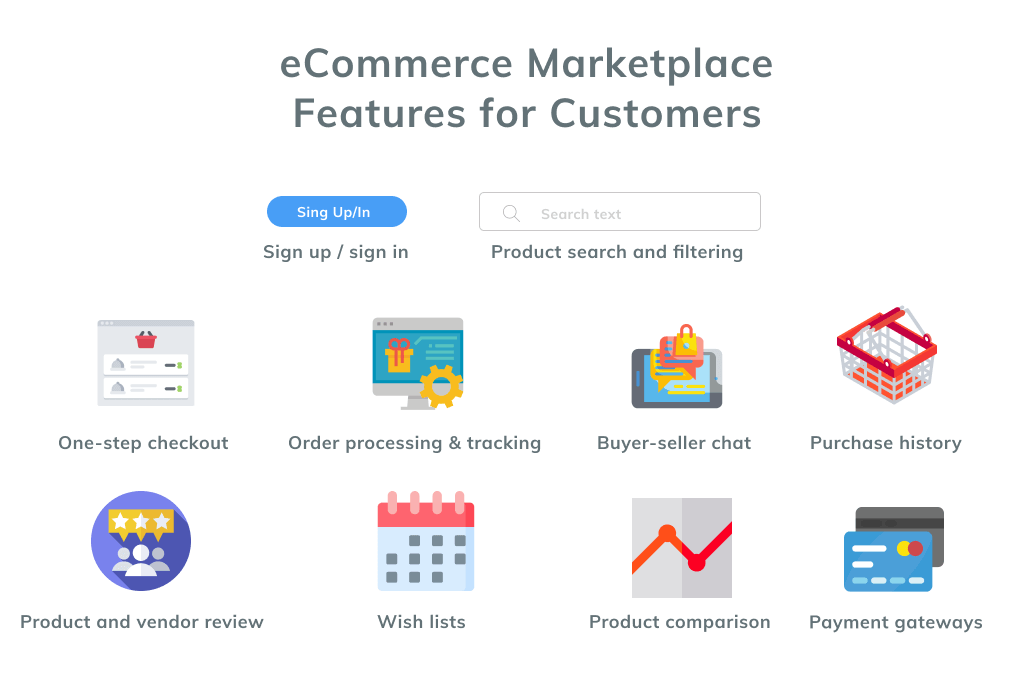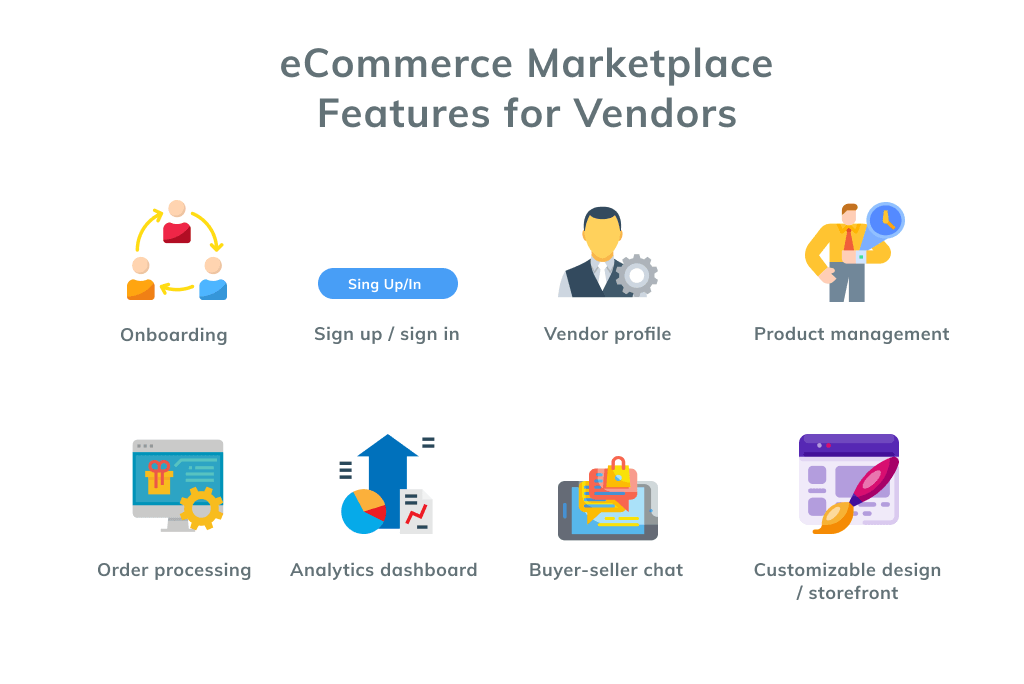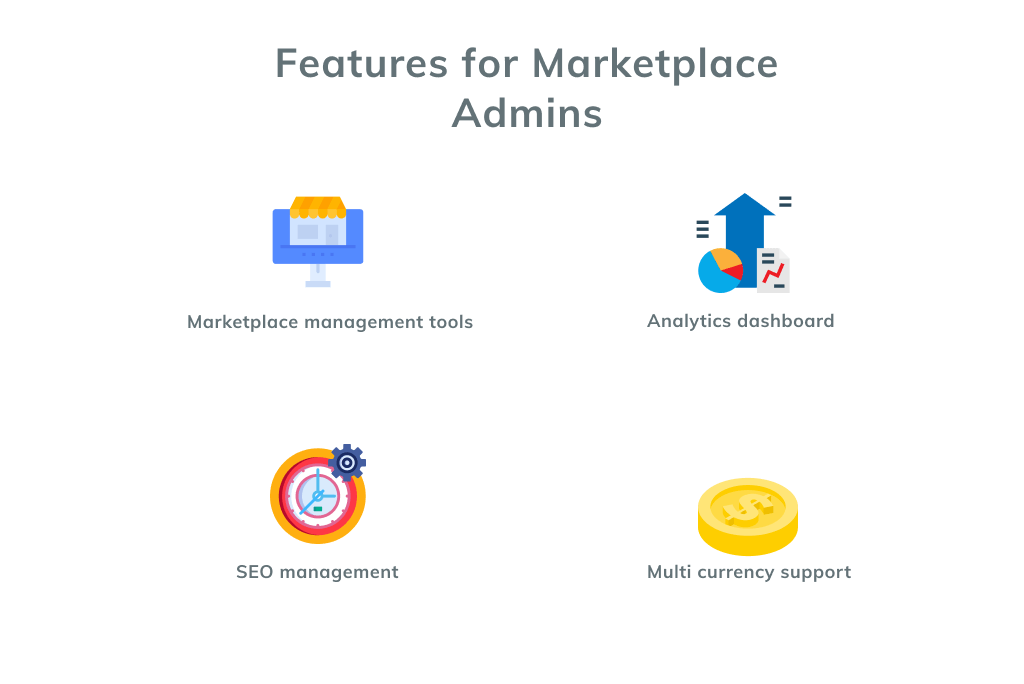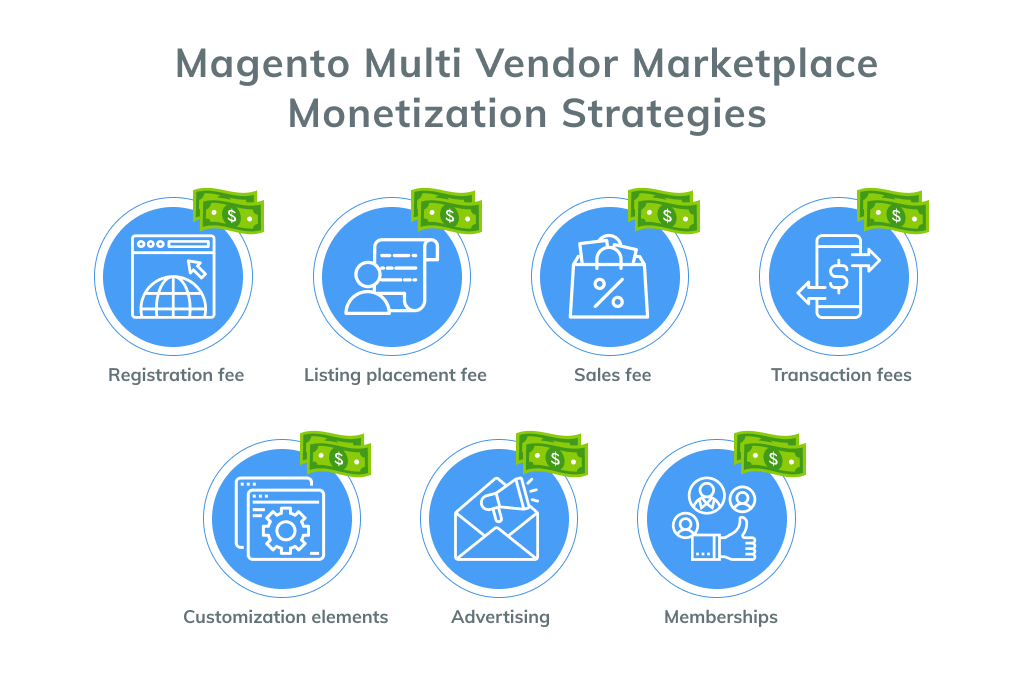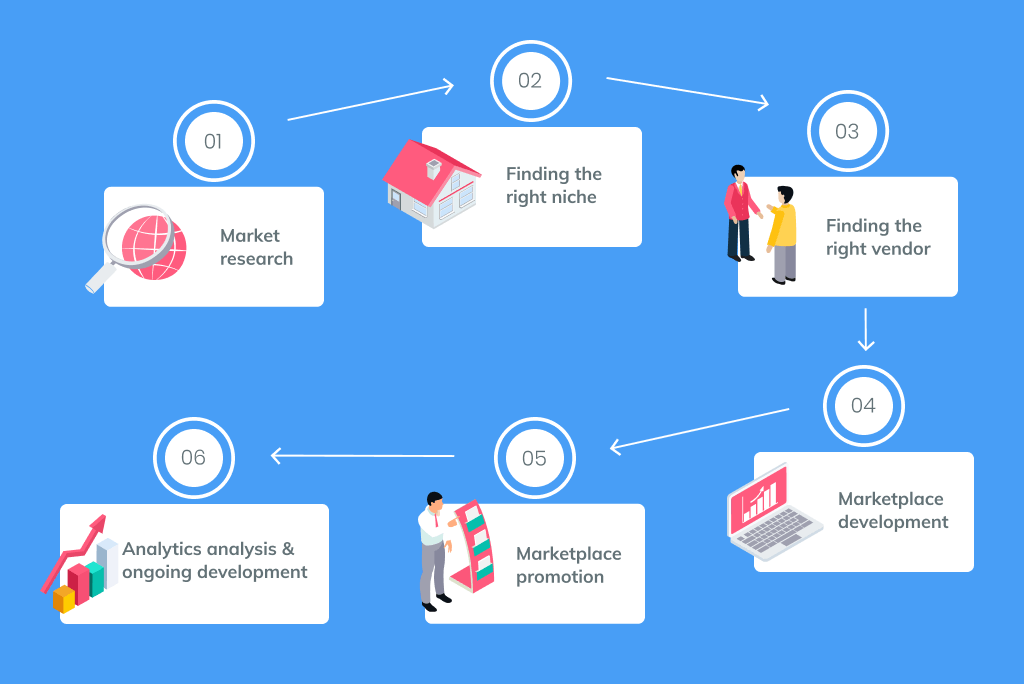Amazon, eBay, Walmart and Etsy are among the most popular marketplaces in the USA and the world. What should you know about them?
In 2019, the top marketplaces generated $2.03 trillion in sales. Alibaba, Amazon and eBay only accounted for 57% of global sales.
The success of these retail giants clearly demonstrates the possible benefits of marketplace development.
In this article, we are going to talk about the whys and hows of building a Magento multi vendor marketplace:
- why creating a marketplace in 2020 is a good idea
- which multi vendor marketplace platform to choose for
- how to make money with your multi vendor eCommerce marketplace
- the cost to create an online marketplace
- step-by-step process to develop a Magento multi vendor marketplace
Read on to learn how to repeat the success of the world-famous retail giants.
Let’s jump right into details.
Why Create an Online Marketplace in 2020
What is a multi vendor marketplace?
Multi vendor online marketplaces offer a lot of opportunities for businesses that decide to pursue the idea of their development. Unlike traditional online stores, the owner of a marketplace is not necessarily a seller there. You can follow a way of Etsy and only offer a platform for others to sell products or be like Amazon and offer your products alongside other sellers.
As the owner of a marketplace, you will be responsible for the following tasks:
- Development of multi vendor eCommerce platform
- Moderation of sellers and customers
- Marketing of the platform
- Data and transactions security
In case you decide to create an online marketplace, you will perform the role of the admin who is responsible for a lot of business and legal tasks.
Today, a multi vendor marketplace can become a successful business opportunity.
Customers prefer marketplaces for repeat purchases. Almost 47% of consumers choose marketplaces for repeat purchases, 34% prefer retailers and only 20% buy directly from brands. Therefore, marketplaces show better results in customer retention.
The vast majority of markets are worth 1-50 billion U.S. dollars. At the same time, the vast majority of them were launched in the last 7 years. These numbers indicate a possible huge and rapid growth of marketplaces as compared to common online stores.
In 2018, third-party sales via marketplace accounted for 80% of the eCommerce Gross Merchandise Volume worldwide. Direct sales accounted only for 20% of GMV.
The main benefits of running such a marketplace are the ability to attract different groups of customers, easier promotion, potential multi-billion growth,and much more. Read on the article to learn how to create a multi vendor marketplace and bring it to success.
Why Build a Magento 2 Multi Vendor Marketplace
After you decide to build a marketplace, you need to find the best solution that will allow you to develop an eCommerce marketplace fast and within your budget. There are a lot of options that you can consider. Still, many fail to provide the needed set of features, payment gateways, security levels, etc.
When you are considering how to create an online marketplace, pay close attention to Magento. This is one of the most powerful eCommerce platforms on the market that stands out among competitors thanks to the powerful set of features, customization and provided scalability. Just take a look at the main benefits that you will get if you decide to build a Magento multi vendor marketplace:
- High performance with Varnish caching
- More than 50 payment gateways integrated out of the box
- A huge number of extensions and modules available
- Easy integration with third-party software and APIs
- A free version that you can use without paying a cent
- Full PWA support for a superior mobile experience and lightning-fast performance
- Unlimited scalability and customization
Magento is one of the platforms best suited for eCommerce marketplace development. The Magento company regularly releases updates, brings new features, and enhances security. With Magento, you don’t have to worry about problems with PCI Compliance, as the platform takes on a huge part of the work.
Do you want to discover all the benefits of Magento 2?
Check out the article Magento 2 Features: Open Source Edition. You will learn what Magento can offer to the eCommerce business and why this platform is called to be the top solution on the market.
Features for Magento Multi Vendor Marketplace
Marketplaces consist of 3 main modules:
- Marketplace for customers
- Admin panel for sellers
- Admin panel for marketplace owners
Each of the parts has its own set of features. You need to decide on the functionality before you start Magento multi vendor marketplace development. You can start with basic features and add advanced ones with the further iterations of your eCommerce marketplace after you have successfully tested and validated your idea.
Let’s take a look at the features that constitute solutions for vendors, customers, and marketplace admins.
Features for Customers
Here is a short overview of all features for shoppers that you can add to your Magento multi vendor marketplace.
- Sign up / sign in – can be implemented in different forms, including registration and user verification with email, phone number, social media, etc.
- Product search and filtering – your goal is to provide customers with a fast way of finding the products needed. You can add the ability to filter products by different attributes, e.g. by size, color, brand, etc.
- One-step checkout – having a one-step checkout is the requirement of today and one of the best solutions that can reduce customer abandonment rates. One-step checkout can be integrated with social login for a faster shopping process.
- Order processing & tracking – showing the status of orders helps to reduce customer anxiety, as they see that their order is being processed and can track its status.
- Buyer-seller chat – allow customers to have direct communication with sellers inside a live built-in chat.
- Product and vendor review – customers should have the ability to rate products and vendors, share their feedback on the shopping experience. It might be a good idea to add the feature allowing them to share their feedback about their experience with your marketplace as well.
- Purchase history – provide insight into the history of orders for all customers. This feature can be combined with the order processing and tracking, and organized into a single page with the statuses of fulfilled orders and orders still in progress.
- Wish lists – it’s a nice-to-have feature that allows customers to add products they like to personal checklists for future purchases.
- Product comparison – this feature is necessary for all marketplaces, as it allows to make the right choice regarding products.
- Payment gateways – to allow customers to pay for products right on your Magento multi vendor marketplace.
Magento 2 Marketplace: Features for Vendors
When creating a Magento multi vendor marketplace, consider adding the features from the list below for vendors.
- Onboarding – there are a lot of marketplaces where sellers can place their products. Therefore, making fast onboarding is beneficial, since they won’t need to spend a lot of time trying to find out how everything works.
- Signup & sign in – you can integrate this feature with social media, email, and phone number. One of the possible realizations is to allow the assignment of a few managers to a single vendor account and assignment of different roles to them.
- Vendor profile – here merchants should have an ability to manage their business information, change data, add new bank accounts, etc.
- Product management – allow sellers to add products fast, provide them with the ability to upload products in bulk, quickly change information, update images, videos, etc.
- Order processing – this feature for a multi vendor marketplace can be implemented in different ways. You can provide vendors with different features, like notifications about new orders, changes in them, provide access to shipping method management, transactions, and much more.
- Analytics dashboard – access to analytics dashboards provides sellers with insight into their performance, bestsellers, conversions, etc. You need to create an advanced and user-friendly dashboard that will provide sellers with all useful data.
- Buyer-seller chat – implementation of this feature will help sellers quickly answer all product-related questions, help customers when they encounter difficulties, and provide other information.
In addition to the basic features, you can add some advanced features that will help the life of vendors easier:
- Reputation bar – allows sellers to track their reputation metrics based on customer feedback and compare it with the reputation of their competitors. This feature is useful as it allows to spot any problems within processes and address them accordingly.
- Listing promotion feature – this is a very important feature as it helps sellers to convert more customers and for you to make money with your Magento multi vendor marketplace. This feature is present in many marketplaces, Amazon and Etsy included.
- Customizable design/storefront – this is one of the most interesting advanced features. You can see a very good realization of it on Etsy. Every seller can create a storefront on the marketplace with branded designs. Such a feature allows companies to differentiate themselves from other sellers.
- Multi-user access – allow creating seller accounts with multi-user access so that merchants could add their team members and assign different roles to them.
- Integration with eCommerce platforms – as many sellers engage in multichannel retail, you might make their lives easier by allowing to automatically upload products to your Magento multi vendor marketplace from top eCommerce platforms like Magento, WooCommerce, etc. With the help of this feature, they will be able to upload products to your marketplace automatically, which will increase the number of listed products and potentially attract more sellers.
- SEO tools – provide sellers with built-in SEO tools that will help them bring their products to the first positions in search results.
How to Create an Online Marketplace: Admin Features
Marketplaces have admins who manage sellers, content on the marketplace, customers and all activities involved.
- Marketplace management tools – as admins oversee all operations on the marketplace, they should be able to moderate customers, sellers, reviews, and other information.
- Analytics dashboard – this feature will allow admins to track how many sales the marketplace generated, which merchants converted more customers, how much they earned, and how much the marketplace generated in revenue.
- SEO management – admins also manage SEO techniques used within the platform, control their effectiveness, etc.
- Multi-currency support – if you decide to move with your marketplace to the international arena, you will need to add multilingual and multi-currency support. Admins should have access to the tools allowing them to control such operations and features.
The list of features for a multi vendor marketplace is huge. The best choice is not to try to copy Amazon or another marketplace but come up with a really unique idea that will attract both sellers and shoppers with a seamless experience, many integrations, ease of use, and other advantages.
Revenue Streams for Magento Multi Vendor Marketplace
When you build a Magento multi vendor marketplace, you have the main goal – making money with your new eCommerce business.
How do marketplaces make money?
There are a number of possible monetization strategies. You can either choose one of them or combine a few, just like Amazon, Etsy, eBay, and other marketplaces do.
Let’s investigate how to make money with a multi vendor marketplace.
- Registration fee – vendor registration can be either free or paid. You can provide sellers with free registration and allow to add additional users to their account for a fee or take some money for vendor registration.
- Listing placement fee – paid listing payments can bring you a significant amount of money. For example, Etsy charges you $0.20 for each product listing on their marketplace. The listing lasts for four months or until the item is sold. Merchants need to pay an additional price to renew their listings after their expiration date.
- Sales fee – Etsy, Amazon, eBay, and many other marketplaces make money on each sale that merchants generate. They take a certain percent from the final value fee and some charge different fees based on product types.
- Transaction fees – in addition to other fees, you can set up transaction fees for each payment. For example, if sellers use Etsy Payments, the marketplace charges 3% + $0.25 for each payment processing.
- Customization elements – if you decide to allow sellers to customize their storefronts on your Magento multi vendor marketplace, you can create a store where you will sell different templates, themes, and other visual elements that will help sellers quickly implement storefront customization.
- Advertising – as a marketplace has hundreds or even thousands of sellers, the battle for customers’ attention becomes real. Provide them with built-in product promotion tools. You can charge them with a fee for each promoted product based on category, place in search results, etc. and take money for each product sold, combining a few monetization strategies into one.
- Memberships – another possible solution is to offer paid membership to customers. You can offer different benefits for members of your marketplace, like free shipping, access to promotions, etc.
The above is just a small overview of some basic and advanced monetization strategies that can be used for an eCommerce marketplace.
How to Create an Online Marketplace in 6 Steps
Now that you know the main elements of a Magento 2 marketplace, let’s take a look at a step-by-step plan to create an online marketplace.
- Market research – analyze the market and your future competitors, including their monetization strategies, unique value propositions, niche, number of integrated payment gateways, etc. At the end of this research, you should have a document with information on the main players in the region of your interest.
- Find the right niche – creating a Magento multi vendor marketplace is difficult and it’s even more challenging to compete with such giants as Amazon, Walmart, and other local brands. Instead of trying to copy your competitors, you need to come up with a unique value proposition. Based on the collected data, decide how you can set your marketplace, and attract customers.
- Find the right Magento development vendor – find a company that will help you develop an eCommerce marketplace. Look for companies with previous experience in the sphere, availability of senior developers, and positive reviews on such platforms as Clutch, The Manifest, ITFirms, etc.
- Magento 2 marketplace development – this is the main stage of creating your own marketplace. At this phase, you will work closely with your vendor to implement all the features of your marketplace. Usually, this stage consists of business analysis, UX/UI design, development , and project deployment. One of the possible solutions is building a Magento PWA, which will allow you to provide seamless shopping experience across devices and save money on the development of mobile applications.
- Magento multi vendor marketplace promotion – after you successfully launch your new marketplace, apply a comprehensive marketing strategy to make sellers and customers aware of it. You should start working on your marketing even before marketplace lunch to find vendors who will be interested in selling there.
- Analytics analysis & further development – analyze the behavior of first customers and vendors, ask for their feedback, and use the collected data to plan for further marketplace development and improvement.
Do you want to discover the benefits of Progressive Web Apps for eCommerce?
Check the article Magento PWA: Features, Technical and Business Insights. You will learn what PWA is, how it works, the main benefits, and why big companies are migrating to PWA.
How Much Does It Cost to Build a Magento Multi Vendor Marketplace?
The cost to develop a Magento 2 marketplace depends on the number of factors:
- Magento 2 version as you can choose Magento Open Source, Magento Commerce,and Magento Commerce Cloud.
- Cloud hosting where you will host your marketplace and which will be responsible for all backend operations.
- Region to which you will outsource Magento multi vendor marketplace development.
- The number of features that you will implement in your marketplace.
Based on all these factors, the price to create an online marketplace can vary from $10,000 to $100,000. When outsourcing eCommerce development, be aware of the cost differences. For example, in the USA, the hourly rate will be $150-200 on average. An average hourly rate in Europe is around $50 per hour, which makes this region a much more attractive destination for eCommerce development outsourcing.
GoMage’s Experience in Magento Multi Vendor Marketplace Development
GoMage team has been providing Magento development services for over 10 years now. Our portfolio includes projects of different size and complexity, starting from small stores to huge Magento multi vendor marketplaces.
Shirtee is a worldwide platform for self-design and customized clothes and accessories. The platform provides print-on-demand services and provides the ability to customize products with designs provided by third-party designers on the platform.
GoMage helped Shirtee to implement a lot of features needed for product customization. Cooperation with the client started with GoMage Product Designer extension customization and turned into a long-term ongoing development and support. Users now can create a product with a unique design in literally three clicks.
The image below demonstrates the main services we provided and the results that we helped our client to achieve with the new website.
Magento Multi Vendor Marketplace: Final Notes
Building an online marketplace today is a great business opportunity and a way to move far beyond a traditional online store. The resources you need are fully justified by the results you can get in the future. Today is the right time to pursue the idea and turn it into a successful business during the years to follow.


